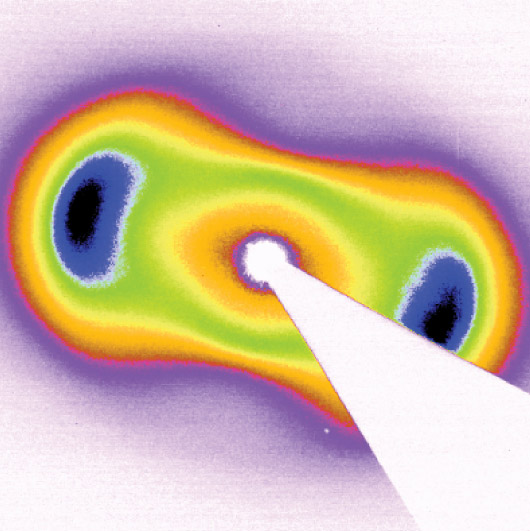- Home
- News
- Spotlight on Science
- Biaxial liquid crystals...
Biaxial liquid crystals found in colloidal dispersions
30-03-2010
Biaxial liquid crystals in goethite dispersions were discovered using small-angle X-ray scattering. Uniaxial liquid crystals, with only one optical axis, are widely used in liquid crystal displays (LCDs). Biaxial liquid crystals, with full 3D optical anisotropy, can make displays and optical switches much faster and might open doors to new 3D technologies.
Share
Liquid crystals, which are formed by highly anisotropic molecules, combine properties of liquids and crystals. They flow like a liquid but have the anisotropic properties of a crystal since molecules are aligned parallel to each other. Due to the necessity to fill up the space, elongated rod-like molecules tend to orient their long axis parallel to each other while flat disc-like molecules align their shortest axis. An interesting situation was predicted 40 years ago for board-like molecules, which have three distinctly different dimensions: the length L, the width W, and the thickness T (see Figure 1a) [1]. If L/W ≈ W/T, the molecular shape is exactly in between rod-like and disc-like. In this case the packing efficiency gain due to the alignment of the longest axis L is comparable to the profit due to the alignment of the shortest dimension T. A biaxial nematic phase is obtained, where the molecules are fully aligned (Figures 1b and 1c).
 |
|
Figure 1. a) Idealised shape of a goethite particle; b) biaxial nematic phase oriented with its long axis perpendicular to the plane and c) with its shortest axis perpendicular to the plane. |
Due to the long-range alignment, the optical response of liquid crystals is also anisotropic and depends on the light polarisation direction. This, together with the ease of turning the optical axis, is employed to manipulate light in LCDs and other optoelectronic devices. Liquid crystals, which are currently used in LCDs, are uniaxial. Their index of refraction has two principal values: nz for the light polarised along the optical axis z and nx = ny ≠ nz for any polarisation orthogonal to it. Biaxial ordering decouples all three principal refractive indices: nx ≠ ny ≠ nz. This additional degree of freedom gives extra room for novel applications including 3D optoelectronic devices, which could be able to simultaneously manipulate light waves coming from different directions. For example, modern LCDs work best when light passes straight through the liquid crystal cells. However, if one uses a ‘wrong’ viewing angle, one gets an incorrect image, where the colours can be inverted. Here biaxial ordering could help, since by tuning the third principal index of refraction in the direction of the cell normal, the light polarisation can be controlled in a wider range of viewing angles. Moreover, if the long molecular axis L is fixed, switching the liquid crystal cells by turning the molecules around L can be faster.
Since its theoretical prediction [1], researchers have been on a quest for the biaxial nematic phase. Some years ago the formation of such a phase was reported in a system of complex banana-shaped molecules [2,3], but it remained a topic of intense debate. Some researchers believed that the observations can also originate from the complex internal structure of the crystals. Recent experiments carried out at beamline BM26 (DUBBLE CRG) revealed the existence of biaxial liquid crystals in a much simpler system of inorganic colloidal particles dispersed in water.
Board-like goethite (α-FeOOH) particles are a good candidate to form biaxial phases since they can be synthesised with dimensions L/W ≈ W/T (Figure 1a). X-ray scattering showed that these particles do indeed spontaneously align along all three dimensions. In order to probe the full 3D structure in more detail, a small magnetic field was used to rotate the domains (using the variable permanent magnet of beamline ID02, which is able to apply the field normal as well as parallel to the beam). Figure 2 shows an example of the scattering pattern of the biaxial phase. Short-range correlations of the order of the width and thickness of the particles can be clearly observed in two orthogonal directions. The corresponding particle arrangement is sketched in Figure 1b. By aligning the particles with their long axis perpendicular to the X-ray beam, correlations in the third dimension were also observed. In addition to the biaxial nematic, a biaxial smectic phase has also been unambiguously observed.
 |
|
Figure 2. X-ray scattering pattern of the biaxial nematic phase of goethite, oriented with its longest axis along the X-ray beam. |
These goethite particles cannot be used directly in optical applications since they strongly absorb light. In addition they are too large with an associated slow (switching) dynamics. However, the proof of principle is now obtained in a system that closely resembles the theoretical model of the four-decades-old prediction [1]. The result shows that other systems do indeed exist in addition to the banana-shaped molecules with their ferroelectric properties. Now biaxial phases can also be sought using alternative candidates with a simpler shape.
References
[1] M.J. Freiser, Physical Review Letters 24, 1041 (1970).
[2] L.A. Madsen, T.J. Dingemans, M. Nakata, E.T. Samulski, Physical Review Letters 92, 145505 (2004).
[3] B.R. Acharya, A. Primak, S. Kumar, Physical Review Letters 92, 145506 (2004).
Principal publication and authors
E. van den Pol, A.V. Petukhov, D.M.E. Thies-Weesie, D.V. Byelov and G.J. Vroege, Experimental realization of biaxial liquid crystal phases in colloidal dispersions of boardlike particles, Physical Review Letters 103, 258301 (2009).
Van ’t Hoff Laboratory for Physical and Colloid Chemistry, Debye Institute for Nanomaterials Science, Utrecht University (The Netherlands)
Top image: X-ray scattering pattern of the biaxial nematic phase of goethite, with the corresponding structure.



